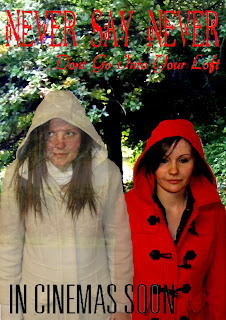For our own magazine cover featuring our film, I decided that I wasn't going to recreate a magazine that already exsisted, so I came up with an original one, I named it Raw.Film, becasue the music magazine that I created during the As project was called Raw.Music, so I thought it worked for both.
To create the magazine I combined my use of Adobe Photoshop and Macromedia Freehand. I used an image of the characters, which I edited the background in photoshop and saved in tiff. format.
I then put it into Macromedia Freehand and worked on the fonts and text to go with the imagery. I exported it as a Jpeg. file:
As this was just an initial idea, I was not overally thrilled about it, as it is very simple, plain and quite dull.
It doesn't grab the attention or jump out at the reader.
When I looked back and the covers of the real magazines I decided that I would do a second magazine cover to make it look more like a magazine.
I went back into adobe and used the park image that I used for the park, but instead of the characters back to back, Tessa suggested that I over lay an image of the white coated girl ontop of the red coat girl, and make the opacity so that the red coat comes through the white.
I used an image of the white girl with her hood up and her back to the camera, and an image of the red coat girl facing the camera.
I used the same technique for cutting and changing the opacity, and I used a font from the generic fonts, called Magneto.
I then flattened the image and converted it to Tiff. Then I imported the image into Macromedia Freehand and worked on the rest of the text there.  I decided to go with a white and gold/yellow for the accents, as these went with the black and white background.
I decided to go with a white and gold/yellow for the accents, as these went with the black and white background.
 I decided to go with a white and gold/yellow for the accents, as these went with the black and white background.
I decided to go with a white and gold/yellow for the accents, as these went with the black and white background. I went back to adobe to crop down another smaller image to include on the cover, and to crop down an image of a barcode.
I prefer this one so much more to my original ideas, because I think it looks so much more like a movie magazine now and I prefer the image and the colours I have chosen as they work much better together, and I think it is much more eye-catching.











































